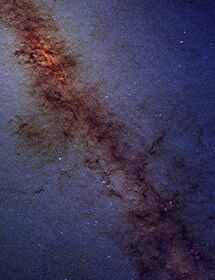Astronomy:Sagittarius B1
From HandWiki
Short description: Luminous H II region

The galactic center of the milky way galaxy in visible light.
Sagittarius B1 also known as Sgr B1 is a luminous H II region in the galactic center.[1] The region is home to a lot of star formation making up 10% of the milky ways star formation in the last 100 million years even when it makes up 1% of the volume of the milky way galaxy.[2] Around six massive stars are located in Sagittarius B1 and evidence that tens of thousands of massive stars formed in SgrB1 within ~10 million years.[3] Stars around ~2 to 7 billion years old seem to be rare inside the inner regions of the nuclear stellar disk and might indicate inside out formation.[4]
References
- ↑ Simpson, Janet P.; Colgan, Sean W. J.; Cotera, Angela S.; Kaufman, Michael J.; Stolovy, Susan R. (2021-02-13) (in en). Sagittarius B1 -- A Patchwork of H II Regions and PhotoDissociation Regions. doi:10.3847/1538-4357/abe636. https://arxiv.org/abs/2102.07031v1.
- ↑ published, Robert Lea (2022-08-26). "'Star factory' at Milky Way's heart seen for the first time" (in en). https://www.space.com/star-factories-discovered-milky-way-center.
- ↑ Anderson, Natali (2022-08-29). "Astronomers Detect Excess of Young Stars in Sagittarius B1 | Sci.News" (in en-US). https://www.sci.news/astronomy/sagittarius-b1-young-stars-11141.html.
- ↑ Nogueras-Lara, Francisco; Schödel, Rainer; Neumayer, Nadine (2022-08-25). "Detection of an excess of young stars in the Galactic Centre Sagittarius B1 region" (in en). Nature Astronomy: 1–7. doi:10.1038/s41550-022-01755-3. ISSN 2397-3366. https://www.nature.com/articles/s41550-022-01755-3.

